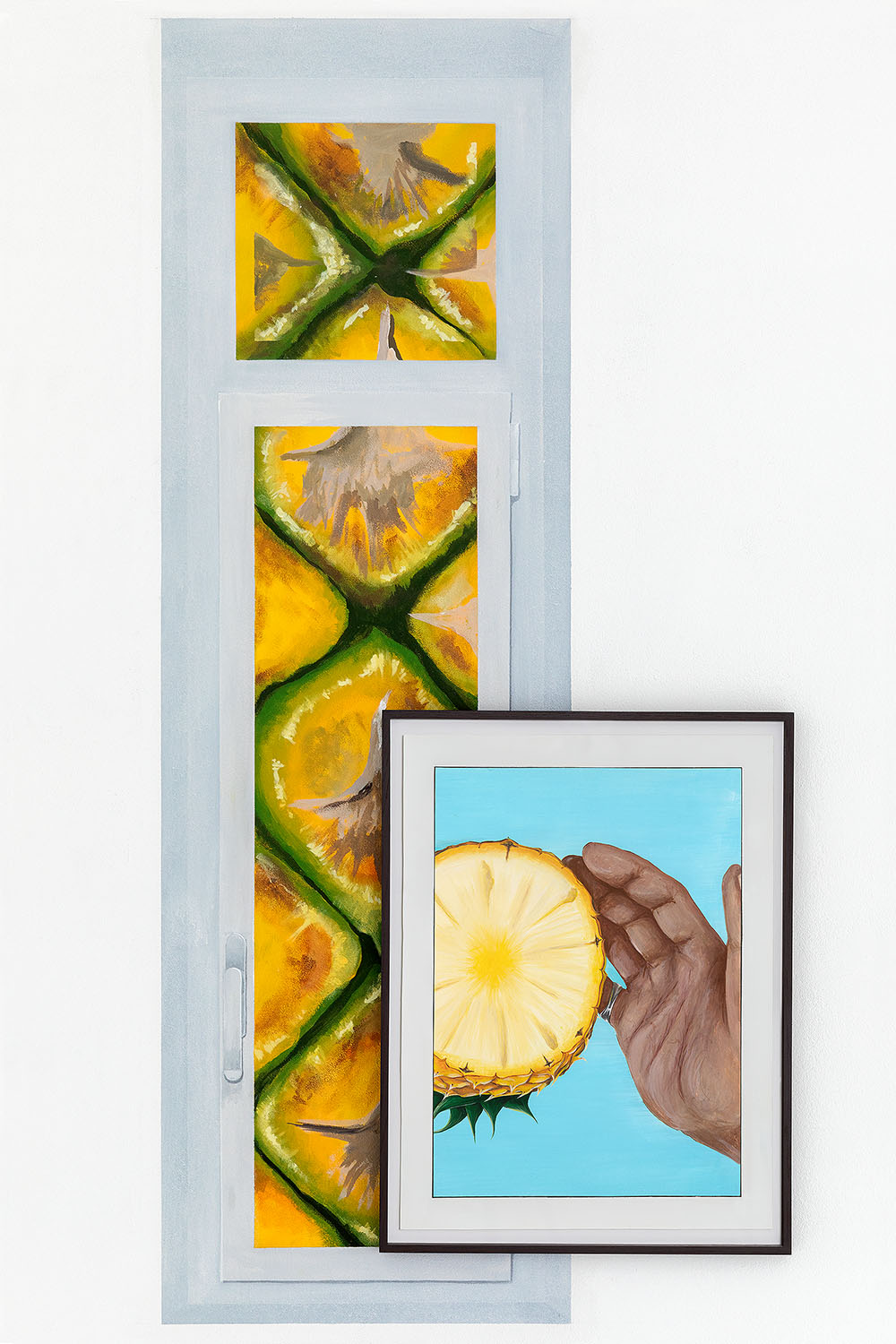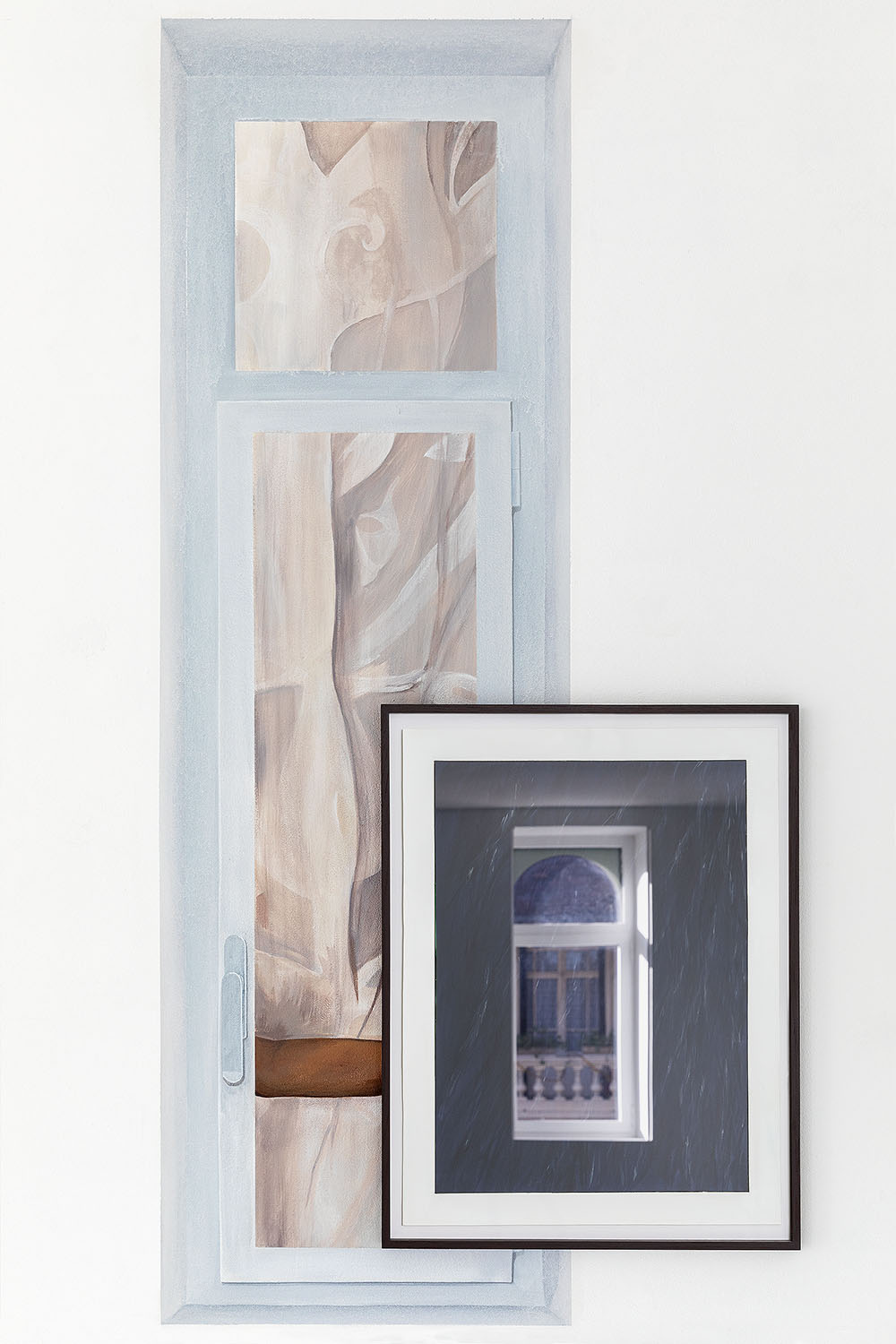Chloé Quenum
Overseas
Janvier – mars 2021
Texte Maïa Hawad















On entre dans Overseas comme dans une capsule : les fenêtres deviennent ici trompe-l’œil peints, fenêtres thématiques qui s’ouvrent sur l’histoire et les représentations majeures de l’ananas. Ce voyage réflexif et sensible s’arrime à l’iconographie exotisante du fruit, jouant et rejouant ses motifs répétitifs afin de mieux les questionner, les sonder, les épuiser.
Une nuque en gros plan répond à un paysage de vagues. Dans une autre fenêtre, les détails de l’écorce d’un ananas dialoguent avec l’intimité d’une chevelure ondulée face à l’océan. La pointe d’un mat de bateau fait irruption : est-ce un bateau de plaisance dans un paysage idyllique ou le navire de Christophe Colomb qui pour la première fois au XVe siècle a transporté l’ananas vers l’Europe, du Brésil au Portugal ? Un peu plus loin, entre une fleur et un ciel azur, une main brune se rapproche d’un fruit, semblant le présenter ou l’offrir. Est-ce une publicité contemporaine vantant le gout de l’ananas ou l’évocation du transfert de richesses et de savoirs au profit de l’Europe, qu’implique en contexte colonial, l’exploitation de ce fruit ? Cette succession de scènes, jouant sur les échelles et les temporalités, suggère toujours un paysage ou une histoire hors cadre qui brouillent les lectures classiques de ces images stéréotypées. Extraites de leurs contextes et mises en perspective, elles deviennent paysages dissonants, signes disruptifs questionnant les histoires enfouies sous la symbolique de l’image exotique. Ces peintures disent en filigrane les complexités et violences des circulations transocéaniques de l’ananas.
Overseas expose une cartographie de stéréotypes qui perdurent. C’est peut-être ce que nous indique Teardrop, ce porte manteau-œil au nom évocateur, qui semble scruter ces images et leurs spectateurs, les engageant à fouiller ce que ces représentations laissent aux marges. Et à interroger à travers elles, qui parle et pour qui ?
Du motif emblématique du fruit exotique nait ainsi un écheveau de questions et d’histoires : histoire de déplacement, de circulation mais aussi de conquête mettant en lumière dans la géographie des végétaux, les traces du colonial dans le post-colonial.
Maïa Hawad
…………….
Overseas springs from Chloé Quenum’s research into the pineapple and this originally South American fruit’s movements between continents and over the centuries. Taking as her starting point the pineapple, which has become a fixture in the stalls of Western markets since the 1980s, the artist invites us on a journey to the heart of the thing that creates exoticism and our connections with an “elsewhere.”
We enter Overseas as we would a capsule, that is, the gallery windows have become trompe-l’oeil paintings of a sort, thematic windows that open onto history and some of the major depictions of the pineapple. This reflexive sensitive journey is bound up with the exoticizing iconography of the fruit, playing with its repetitive motifs over and over in order to question, sound and exhaust them.
The back of an anonymous neck in close up balances a seascape of waves. In another window, the details of a pineapple peel spark a dialogue with the intimacy of a wavy head of hair seen in front of the ocean. The point of a ship’s mast suddenly appears. Is it part of a pleasure boat in an idyllic setting or Christopher Columbus’s ship transporting for the first time, in the 15th century, the pineapple to Europe, from Brazil to Portugal? A little further along, between a flower and an azure sky, a brown hand reaches out for a pineapple, seeming to show or offer it. Is it a contemporary advertisement touting the taste of the pineapple, or an allusion to the transfer of wealth and knowledge that profited Europe, which the exploitation of this fruit in a colonial context implies? Playing with scale and timelines, this series of scenes always suggests some landscape or story beyond the frame that confuses or blurs the classic readings of such stereotypical images. Removed from their context and put in perspective, they become dissonant landscapes, disruptive signs questioning the stories and the history buried beneath the symbolism of the exotic image. These paintings give veiled expression to the complexities and violence of the transoceanic movement of the pineapple.
Overseas exposes a cartography of stereotypes that persist. This is perhaps what the coat rack-eye with the evocative name of Teardrop is telling us. It seems to scrutinize these images and their viewers, committing the latter to delve into what these representations leave on the margins. And to question through them who is speaking and for whom.
The emblematic motif of this exotic fruit gives rise to a tangle of questions and stories, i.e., the history of displacement and circulation but also conquest, illuminating in plant geography the traces of the colonial in the postcolonial.
Maïa Hawad
Crédit photos : Romain Darnaud
La production de l’exposition a bénéficié du soutien de la Fondation de Artistes
Overseas – Chloé Quenum
https://contemporaryartdaily.com/2021/02/chloe-quenum-at-les-bains-douches/
https://kubaparis.com/chloe-quenum-overseas-at-les-bains-douches/
http://www.daily-lazy.com/2021/01/chloe-quenum-at-les-bains-douches.html
https://slash-paris.com/articles/chloe-quenum-les-bains-douches-alencon
Chloé Quenum